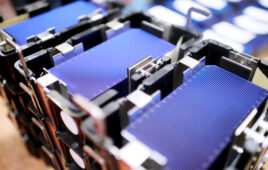Central inverters are falling out of fashion. Cormac Gilligan, research manager of solar and energy storage at IHS Markit, said that string inverters are being used in increasingly larger systems―going beyond even large commercial projects into the utility space.
This is driven by string inverter manufacturers offering increased power ratings.
“In the past, 20 kW was kind of the average size [of string inverters]. Then it went to 40 kW, and increasingly we are seeing 60 and 80 kW becoming the norm,” Gilligan said. “Also, in recent times, we’ve seen next-generation products above the 100-kW mark. In the future, I think we’ll get very close to the 200-kW range.”
Some string inverter manufacturers are moving into new markets to meet the additional demand. For example, China-based Huawei recently expanded into the United States.
But other suppliers are taking another approach. Companies like Sungrow and SMA offer both three-phase string inverters and central inverters, giving customers a choice and providing their expertise to help find the best solution for each site.
“What this is doing, fundamentally, is allowing this solution or architecture to compete with central inverters on a price basis. It’s also reducing the number of units in the field, therefore reducing the labor costs and cost of installation,” Gilligan said.
Still some manufacturers are just sticking with central inverters, moving toward a “module” solution that can stay online even if one unit is down. These modular inverters offer the benefits of both string and central inverters. Each inverters is made up of multiple units that can be easily replaced out in the field. So in the event of a fault, the remaining units will still function instead of the entire inverter going offline.
“If one unit is down, you don’t lose, let’s say, 2 or 4 MW,” Gilligan said. “Suppliers like Power Electronics, TMEIC and others are really promoting this type of solution.”
The module-level power electronics (MLPE) market is also growing, mainly due to evolving NEC requirements. While NEC 2014 requirements for rapid shutdown could be met with a string inverter or rapid-shutdown box within 10 ft of the array, NEC 2017 requires shutdown within the actual PV array boundary.
“Module-level power electronics, like microinverters and power optimizers, are the most obvious and commercially available solution to meet this requirement,” said Miguel De Jesus, solar market analyst at IHS Markit. “So obviously [the new requirement] has been a big boost to those suppliers.”
Though most MLPE growth has occurred in the residential market, De Jesus said MLPEs have been showing up in commercial applications. While string inverters have traditionally been preferred in commercial applications because of their lower price, new rapid-shutdown requirements add pressure for commercial installers to consider power optimizers or microinverters. More partnerships between MLPE and module manufacturers, such as LG and Panasonic, are also helping to reduce installation cost.






In the commercial applications >5M, I think modular central inverter is much better than the string inverter as the first type will not completely shut-down and corrective maintenance can conduct without need to switch off and the plant downtime consequences will be minimised.